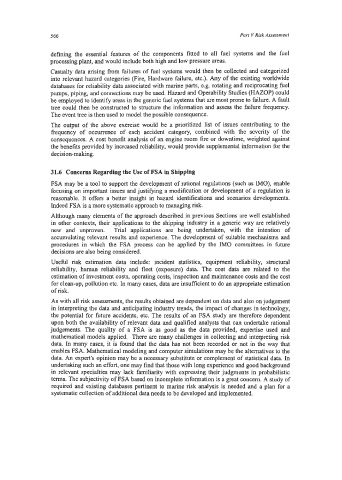Page 590 - Marine Structural Design
P. 590
566 Part V Risk Assessment
defining the essential features of the components fitted to all fuel systems and the fuel
processing plant, and would include both high and low pressure areas.
Casualty data arising from failures of fuel systems would then be collected and categorized
into relevant hazard categories (Fire, Hardware failure, etc.). Any of the existing worldwide
databases for reliability data associated with marine parts, e.g. rotating and reciprocating fuel
pumps, piping, and connections may be used. Hazard and Operability Studies (HAZOP) could
be employed to identify areas in the generic fuel systems that are most prone to failure. A fault
tree could then be constructed to structure the information and assess the failure frequency.
The event tree is then used to model the possible consequence.
The output of the above exercise would be a prioritized list of issues contributing to the
frequency of occurrence of each accident category, combined with the severity of the
consequences. A cost benefit analysis of an engine room fire or downtime, weighted against
the benefits provided by increased reliability, would provide supplemental information for the
decision-making.
31.6 Concerns Regarding the Use of FSA in Shipping
FSA may be a tool to support the development of rational regulations (such as IMO), enable
focusing on important issues and justifying a modification or development of a regulation is
reasonable. It offers a better insight in hazard identifications and scenarios developments.
Indeed FSA is a more systematic approach to managing risk.
Although many elements of the approach described in previous Sections are well established
in other contexts, their applications to the shipping industry in a generic way are relatively
new and unproven. Trial applications are being undertaken, with the intention of
accumulating relevant results and experience. The development of suitable mechanisms and
procedures in which the FSA process can be applied by the IMO committees in future
decisions are also being considered.
Useful risk estimation data include: incident statistics, equipment reliability, structural
reliability, human reliability and fleet (exposure) data. The cost data are related to the
estimation of investment costs, operating costs, inspection and maintenance costs and the cost
for clean-up, pollution etc. In many cases, data are insufficient to do an appropriate estimation
of risk.
As with all risk assessments, the results obtained are dependent on data and also on judgement
in interpreting the data and anticipating industry trends, the impact of changes in technology,
the potential for future accidents, etc. The results of an FSA study are therefore dependent
upon both the availability of relevant data and qualified analysts that can undertake rational
judgements. The quality of a FSA is as good as the data provided, expertise used and
mathematical models applied. There are many challenges in collecting and interpreting risk
data. In many cases, it is found that the data has not been recorded or not in the way that
enables FSA. Mathematical modeling and computer simulations may be the alternatives to the
data. An expert's opinion may be a necessary substitute or complement of statistical data. In
undertaking such an effort, one may find that those with long experience and good background
in relevant specialties may lack familiarity with expressing their judgments in probabilistic
terms. The subjectivity of FSA based on incomplete information is a great concern. A study of
required and existing databases pertinent to marine risk analysis is needed and a plan for a
systematic collection of additional data needs to be developed and implemented.

